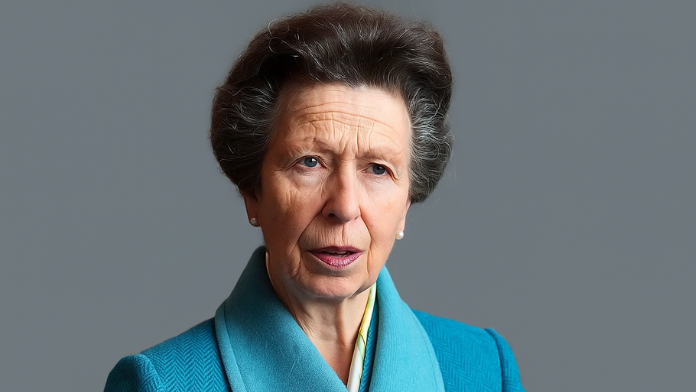
In an age of constant royal scrutiny, fleeting fame, and shifting public loyalties, Princess Anne has remained an enduring emblem of steadfastness. While others in the British royal family often make headlines for glamour, controversy, or change, Anne stands apart for one simple reason: her unwavering dedication to duty. Her journey from a spirited young princess to the Princess Royal, often described as the monarchy’s “hardest-working member,” offers timeless lessons in resilience, service, and integrity.
This article explores how Princess Anne quietly became the royal family’s anchor—balancing tradition and modernity while maintaining the Crown’s credibility through consistent service. We’ll trace her upbringing, achievements, family life, charitable commitments, and her influence on the next generation, including Elizabeth II’s grandchildren. More than a royal biography, this is a story of how character, rather than charisma, secures legacy.
Early Life and Royal Beginnings
A Childhood Shaped by Responsibility
Born on August 15, 1950, at Clarence House in London, Princess Anne was the second child and only daughter of Queen Elizabeth II and Prince Philip, Duke of Edinburgh. From the very beginning, her life was framed by both privilege and responsibility. As the daughter of a newly crowned monarch, Anne’s childhood coincided with a rapidly changing Britain—recovering from post-war austerity and redefining its identity.
Even as a child, Anne stood out for her independence and intelligence. Tutors and palace insiders described her as spirited, direct, and practical—qualities that often contrasted with the expected royal demeanor of formality and restraint. Her early education at Benenden School further shaped her confidence, fostering self-discipline and empathy, traits that would later define her royal service.
The Formation of a Duty-Driven Personality
By her teenage years, Anne had already begun accompanying her parents on royal tours, observing firsthand the delicate balance between tradition and public duty. She absorbed her mother’s quiet authority and her father’s no-nonsense approach to service. These early experiences taught her that leadership within the royal family wasn’t about pageantry—it was about consistency.
Her upbringing within the House of Windsor was demanding but formative. She learned early that public service was both a privilege and a lifelong expectation. This foundation built the resilience that would later define her reputation as the royal family’s unwavering pillar.
From Equestrian Dreams to Olympic Reality
Mastering the Equestrian World
Beyond her royal responsibilities, Anne cultivated a passion for equestrianism—a discipline that mirrored her personal ethos of precision and endurance. Her commitment to the sport was not a hobby but a pursuit of excellence. In 1971, she won the individual gold medal at the European Eventing Championships, signaling to the world that she was more than a royal figurehead—she was a competitor.
Her competitive career reached its peak in 1976 when she represented Great Britain at the Montreal Olympic Games, riding the Queen’s horse, Goodwill. Although she didn’t secure a medal, her participation marked a historical milestone—she became the first member of the British royal family to compete in the Olympics.
The Equestrian Spirit: A Reflection of Her Character
Equestrianism demands discipline, courage, and composure—qualities that mirror Anne’s approach to royal life. She once remarked that horses “don’t respond to titles; they respond to training and trust.” This philosophy encapsulates her grounded nature and practical mindset, setting her apart from more image-conscious royals.
Anne’s achievements in sport built the foundation for her public identity: a hardworking, capable, and determined woman who valued results over appearances. Her approach demonstrated that royal influence could come not from glamour but from example.
The Princess Royal: Duty Above All
The Meaning of “Princess Royal”
In 1987, Queen Elizabeth II formally granted Anne the title of Princess Royal, a distinction traditionally reserved for the monarch’s eldest daughter. The title was more than ceremonial—it acknowledged decades of devotion and professionalism. Anne wore it with humility, continuing to focus on her extensive schedule of engagements rather than the status it conferred.
A Tireless Work Ethic
Among the British royal family, no one matches Princess Anne’s sheer output. In an average year, she attends over 400 public engagements, travels extensively on behalf of the Crown, and serves as patron or president to more than 300 charities and organizations. Her calendar is famously relentless.
Her approach to royal work is methodical and humble. She rarely seeks media attention for her efforts, preferring results over recognition. From supporting Save the Children—of which she has been president since 1970—to promoting maritime safety, health care, and rural education,Princess Anne’s portfolio of causes reflects a grounded understanding of Britain’s social fabric.
Leading by Example
Unlike some of her royal counterparts, Anne has avoided scandal, opting instead for substance. She is often described as pragmatic and stoic, qualities that strengthen her credibility both within and outside palace walls. Her diligence and modesty have earned her the respect of colleagues, world leaders, and the British public alike.
Her ethos is simple: “Show up, do the job, and don’t complain.” That philosophy has made her a model of the kind of service-oriented leadership modern institutions crave.
Princess Anne and Family Life

Balancing Duty and Motherhood
In 1973, Anne married Captain Mark Phillips, a fellow equestrian. Together, they had two children—Peter Phillips and Zara Tindall (née Phillips). In a move that reflected her independent streak, Anne declined royal titles for her children, preferring they build lives outside the constraints of royal hierarchy.
This decision was revolutionary for its time. By choosing not to make her children princes or princesses, she gave them the freedom to pursue their own paths while maintaining close family ties. It also demonstrated her foresight: understanding that not every descendant of Elizabeth II’s grandchildren needed to carry royal expectations.
Lessons in Practical Parenting
Princess Anne’s relationship with her children is characterized by warmth, discipline, and mutual respect. Zara Tindall, herself an accomplished equestrian and Olympic medalist, often credits her mother for instilling resilience and work ethic.
Anne’s second marriage, to Vice Admiral Sir Timothy Laurence in 1992, was quieter and more private. It offered her stability away from public spectacle, reinforcing her image as grounded and self-assured.
Her personal choices—prioritizing privacy, balance, and authenticity—have helped redefine what royal motherhood can look like in the modern age.
The Royal Family’s Most Reliable Force
The Hardest – Working Royal
Year after year, Princess Anne consistently ranks as the royal family’s most active member in terms of official engagements. Her dedication is not performative; it is practical. She attends rural events, industrial exhibitions, and community initiatives that often receive little press coverage—but these are the engagements that sustain the monarchy’s connection to ordinary citizens.
Anne’s commitment ensures the royal family remains visible and relevant at the grassroots level, not just in grand ceremonies or global headlines. Her humility in action redefines what royal duty means in the 21st century.
A Pillar of Continuity
As the monarchy transitions through generations—from the late Queen Elizabeth II to King Charles III—Princess Anne has emerged as the unshakable constant. Her decades of consistent service provide stability at a time when public opinion about the monarchy fluctuates.
Her reliability is particularly crucial now, as the royal family faces the challenge of maintaining legitimacy and unity amid generational change. In many ways, she embodies the monarchy’s moral compass—devoted, professional, and apolitical.
Leadership Lessons from Princess Anne
1. Consistency Builds Credibility
Whether in monarchy, business, or everyday life, consistency establishes trust. Princess Anne’s decades-long reliability demonstrates that genuine leadership isn’t about charisma but dependability.
2. Service Over Spotlight
Anne rarely seeks attention. Her quiet dedication is a reminder that influence doesn’t always require visibility. True impact often happens behind the scenes.
3. Balance Between Tradition and Adaptability
Her respect for royal protocol coexists with progressive decisions—like forgoing titles for her children. She respects heritage while embracing practicality, a balance every legacy-driven institution must learn.
4. Humility Amplifies Authority
In every engagement, Anne treats individuals—from dignitaries to volunteers—with equal respect. Her authenticity reinforces her authority more effectively than prestige ever could.
Princess Anne’s Role in Modern Monarchy
Navigating the New Era
In today’s rapidly changing society, where public figures are under constant scrutiny, Princess Anne’s low-profile integrity feels refreshingly timeless. She embodies what many believe the monarchy should represent: service, duty, and quiet strength.
Her presence reassures a nation often divided by politics or media spectacle. When newer royals face public challenges, Anne’s stability serves as the monarchy’s moral anchor—grounding the institution in purpose rather than personality.
Mentoring the Next Generation
Her influence extends to younger royals. Both Zara Tindall and Prince William have spoken about Anne’s work ethic and wisdom. As Elizabeth II’s grandchildren take on more responsibility, they often cite her as a model for balancing personal life and public duty.
Her mentorship ensures that the values of dedication and humility endure beyond her generation.
Challenges and Criticisms
Even steadfast figures face scrutiny. Princess Anne’s famously forthright personality sometimes clashes with expectations of royal decorum. She is known for her bluntness—a trait both admired and criticized.
However, her directness has arguably kept her grounded, preventing her from falling into the performative traps of modern celebrity. Unlike some family members, she has avoided scandals, showing that resilience and discretion remain vital virtues in public service.
Legacy of the Princess Anne
A Lifetime of Service
From her early days as a young royal to her present role as an international representative of the monarchy, Princess Anne’s story is one of duty over drama. She has built a life defined by purpose rather than privilege.
Her commitment to public service, her pioneering role in sports, and her insistence on humility have earned her admiration across generations.
The Enduring Anchor
The metaphor of the “anchor” fits perfectly: she keeps the royal ship steady amidst storms of controversy, change, and media turbulence. In a world that rewards visibility, Anne’s quiet resilience proves that strength often works best when it speaks softly.
Her influence will endure long after her engagements end—not because of what she wore or said, but because of what she consistently did.
Conclusion
In an institution often defined by ceremony, Princess Anne brings substance. She embodies what it means to serve with dignity—showing that leadership, at its best, is built on discipline and selflessness.
Her life offers more than royal intrigue; it offers lessons for anyone striving for integrity in a world that prizes appearance over action. Princess Anne’s legacy reminds us that the truest anchors aren’t the loudest—they’re the ones that never drift.
FAQs
1. Who is Princess Anne?
Princess Anne is the only daughter of Queen Elizabeth II and Prince Philip. Born in 1950, she holds the title of Princess Royal and is known for her decades of service and dedication to duty.
2. What does the title “Princess Royal” mean?
The title is traditionally granted to the monarch’s eldest daughter. It is a lifelong honor recognizing her senior status and contribution to the royal family.
3. How many children does Princess Anne have?
Princess Anne has two children—Peter Phillips and Zara Tindall. She chose not to give them royal titles, allowing them greater independence.
4. Why is Princess Anne considered the hardest-working royal?
She consistently attends more annual engagements than any other member of the royal family, often focusing on charitable causes and community initiatives.
5. What sports did Princess Anne compete in?
Princess Anne was an accomplished equestrian, winning the European Eventing Championships in 1971 and representing Great Britain at the 1976 Montreal Olympics.
6. What is Princess Anne’s legacy in the royal family?
Her legacy is defined by consistency, humility, and service. She is widely regarded as the royal family’s most reliable and respected member.
7. How has Princess Anne influenced the younger royals?
Her example of work ethic, modesty, and dedication has inspired younger royals—including her daughter Zara and her nephews William and Harry—to balance public duty with personal authenticity.



